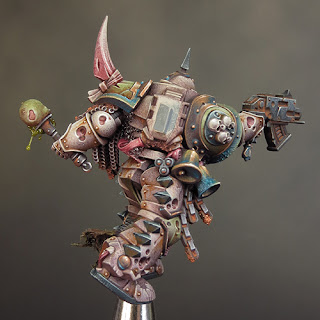That’s just as well because I’ve found that slowing down seems to be the best way to progress with the next phase of Akito’s paintjob. The leather jacket has taken my painting into new territory and I’ve had to focus a lot of time and attention on it. I’ve developed a routine of painting for a couple of hours each day and then reviewing and amending my work the next day before moving on to a new area. That makes for slow progress but progress nonetheless.
The Akito bust screams out for painted material and texture contrasts and, having put a lot of effort into painting smooth skin, it’s time to paint a lot of texture on the leather jacket. I’d intended to paint Akito’s clothing in predominantly black tones but, as always, my plans have evolved as the paintjob developed. I’m now painting the leather a very battered and worn brown. I think this is both a more interesting painting challenge and a more realistic approach to Akito’s costume. Her clothing will have a randomly put together feel as opposed to a carefully colour co-ordinated fashion choice. That seems more appropriate for this character.
I’ve been putting a lot of effort into painting textures in my recent projects and this bust feels like the next step. The larger scale gives a lot of scope for painting texture but it also creates a huge challenge! I’m right out of my comfort zone but that’s no bad thing as it’s keeping me on my toes. Simply stippling over the jacket, as I might in a smaller scale, will not create a distinctive enough texture. Stippling certainly has a place in this paintjob but too much stippling will only serve to create a generic texture. What’s needed here is something more nuanced and distinctive.
This has challenged me to experiment with the marks I make with my brush and I’ve had to work around the problem to find a solution. As I’ve painted the jacket I’ve developed an approach that, I think, is beginning to work. This is something I’ve found especially interesting as it reflects the ongoing development of my painting technique. Going back a few years my stippling was, quite literally, painting with dots now, however, it’s far more varied. More often than not when I stipple I allow the tip of the brush to skip and drag over the surface of the model making a combination of dots, dashes and scribbles.
My colour palette has also undergone some trial and error to find a workable solution. Although predominantly brown I’ve painted the jackets highlights in cooler blue/grey tones as if reflecting the sky while the shadows go to black. This is similar to a NMM technique as leather can be a shiny reflective material. However, this leather is extremely old and worn and, in the most worn areas, the material would be rough and unreflective. To create these areas I’ve used a yellow brown tone and fairly course brush marks.
Colour Palette
Base:
Flat Black/Brown Leather mix (Scalecolour)
Mid Tones:
Brown Leather (Scalecolour), Brown Gray (Scalecolour), Rucksack Tan (P3), Bering Blue (Scalecolour)
Highlights:
Midtone colours + Purity White (Scalecolour)
Overall the painting of this bust has been a process of going back and forth to adjust the balance between the contrast, colours and textures. The jacket is still very much a work in progress but, after some fretting, I’m beginning to feel good about how it’s going.
























































